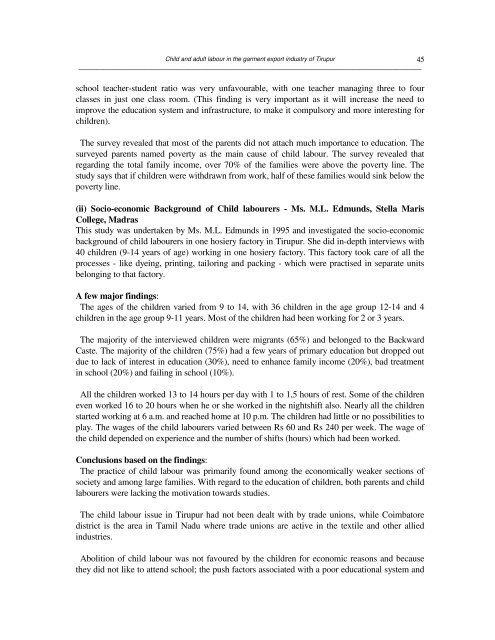You also want an ePaper? Increase the reach of your titles
YUMPU automatically turns print PDFs into web optimized ePapers that Google loves.
<strong>Child</strong> <strong>and</strong> <strong>adult</strong> <strong>labour</strong> <strong>in</strong> <strong>the</strong> <strong>garment</strong> <strong>export</strong> <strong>in</strong>dustry <strong>of</strong> Tirupur<br />
──────────────────────────────────────────────────────────────────────────────────────────────<br />
school teacher-student ratio was very unfavourable, with one teacher manag<strong>in</strong>g three to four<br />
classes <strong>in</strong> just one class room. (This f<strong>in</strong>d<strong>in</strong>g is very important as it will <strong>in</strong>crease <strong>the</strong> need to<br />
improve <strong>the</strong> education system <strong>and</strong> <strong>in</strong>frastructure, to make it compulsory <strong>and</strong> more <strong>in</strong>terest<strong>in</strong>g for<br />
children).<br />
The survey revealed that most <strong>of</strong> <strong>the</strong> parents did not attach much importance to education. The<br />
surveyed parents named poverty as <strong>the</strong> ma<strong>in</strong> cause <strong>of</strong> child <strong>labour</strong>. The survey revealed that<br />
regard<strong>in</strong>g <strong>the</strong> total family <strong>in</strong>come, over 70% <strong>of</strong> <strong>the</strong> families were above <strong>the</strong> poverty l<strong>in</strong>e. The<br />
study says that if children were withdrawn from work, half <strong>of</strong> <strong>the</strong>se families would s<strong>in</strong>k below <strong>the</strong><br />
poverty l<strong>in</strong>e.<br />
(ii) Socio-economic Background <strong>of</strong> <strong>Child</strong> <strong>labour</strong>ers - Ms. M.L. Edmunds, Stella Maris<br />
College, Madras<br />
This study was undertaken by Ms. M.L. Edmunds <strong>in</strong> 1995 <strong>and</strong> <strong>in</strong>vestigated <strong>the</strong> socio-economic<br />
background <strong>of</strong> child <strong>labour</strong>ers <strong>in</strong> one hosiery factory <strong>in</strong> Tirupur. She did <strong>in</strong>-depth <strong>in</strong>terviews with<br />
40 children (9-14 years <strong>of</strong> age) work<strong>in</strong>g <strong>in</strong> one hosiery factory. This factory took care <strong>of</strong> all <strong>the</strong><br />
processes - like dye<strong>in</strong>g, pr<strong>in</strong>t<strong>in</strong>g, tailor<strong>in</strong>g <strong>and</strong> pack<strong>in</strong>g - which were practised <strong>in</strong> separate units<br />
belong<strong>in</strong>g to that factory.<br />
A few major f<strong>in</strong>d<strong>in</strong>gs:<br />
The ages <strong>of</strong> <strong>the</strong> children varied from 9 to 14, with 36 children <strong>in</strong> <strong>the</strong> age group 12-14 <strong>and</strong> 4<br />
children <strong>in</strong> <strong>the</strong> age group 9-11 years. Most <strong>of</strong> <strong>the</strong> children had been work<strong>in</strong>g for 2 or 3 years.<br />
The majority <strong>of</strong> <strong>the</strong> <strong>in</strong>terviewed children were migrants (65%) <strong>and</strong> belonged to <strong>the</strong> Backward<br />
Caste. The majority <strong>of</strong> <strong>the</strong> children (75%) had a few years <strong>of</strong> primary education but dropped out<br />
due to lack <strong>of</strong> <strong>in</strong>terest <strong>in</strong> education (30%), need to enhance family <strong>in</strong>come (20%), bad treatment<br />
<strong>in</strong> school (20%) <strong>and</strong> fail<strong>in</strong>g <strong>in</strong> school (10%).<br />
All <strong>the</strong> children worked 13 to 14 hours per day with 1 to 1,5 hours <strong>of</strong> rest. Some <strong>of</strong> <strong>the</strong> children<br />
even worked 16 to 20 hours when he or she worked <strong>in</strong> <strong>the</strong> nightshift also. Nearly all <strong>the</strong> children<br />
started work<strong>in</strong>g at 6 a.m. <strong>and</strong> reached home at 10 p.m. The children had little or no possibilities to<br />
play. The wages <strong>of</strong> <strong>the</strong> child <strong>labour</strong>ers varied between Rs 60 <strong>and</strong> Rs 240 per week. The wage <strong>of</strong><br />
<strong>the</strong> child depended on experience <strong>and</strong> <strong>the</strong> number <strong>of</strong> shifts (hours) which had been worked.<br />
Conclusions based on <strong>the</strong> f<strong>in</strong>d<strong>in</strong>gs:<br />
The practice <strong>of</strong> child <strong>labour</strong> was primarily found among <strong>the</strong> economically weaker sections <strong>of</strong><br />
society <strong>and</strong> among large families. With regard to <strong>the</strong> education <strong>of</strong> children, both parents <strong>and</strong> child<br />
<strong>labour</strong>ers were lack<strong>in</strong>g <strong>the</strong> motivation towards studies.<br />
The child <strong>labour</strong> issue <strong>in</strong> Tirupur had not been dealt with by trade unions, while Coimbatore<br />
district is <strong>the</strong> area <strong>in</strong> Tamil Nadu where trade unions are active <strong>in</strong> <strong>the</strong> textile <strong>and</strong> o<strong>the</strong>r allied<br />
<strong>in</strong>dustries.<br />
Abolition <strong>of</strong> child <strong>labour</strong> was not favoured by <strong>the</strong> children for economic reasons <strong>and</strong> because<br />
<strong>the</strong>y did not like to attend school; <strong>the</strong> push factors associated with a poor educational system <strong>and</strong><br />
45


















